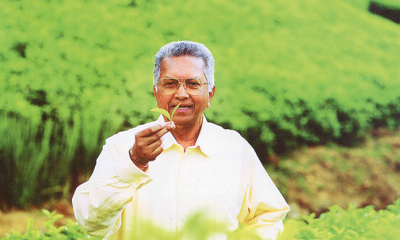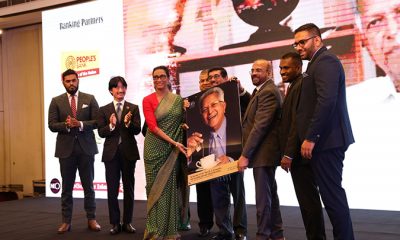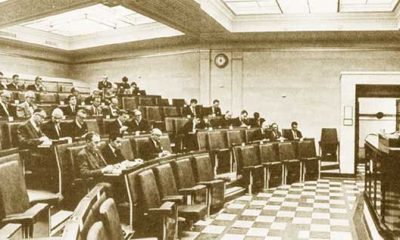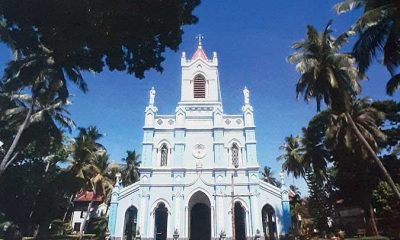Features
An autobigraphy of a remarkable self-made billionaire
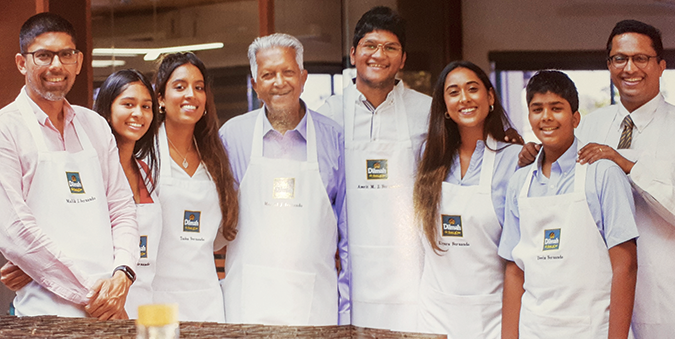
The story of Ceylon Teamaker: MERRIL. J. FERNANDO
by Manik de Silva
Merril J. Fernando’s recently published autobiography would be considered by many to be best story of its kind coming out in recent times, if not all time, of the life and times of a business leader in Sri Lanka. Similar volumes published in recent years that come readily to mind are the life and career stories of C.P. (Chari) de Silva of Aitken Spence, Ken Balendra of John Keells, Hemaka Amarasuriya of Singer and Rienzie Weeraratne of Unilever.
Undoubtedly many more resources have been poured into this production than to its predecessors. The result is spectacular both in appearance and substance. Over 200 interesting photographs scattered throughout the well-designed volume, makes reading its 400+ pages easy. The reader cannot but be impressed about MJF’s meticulous record keeping that is a feature of the book; also the author’s deliberate decision not to pull back his punches aimed at some prominent figures in the country, many of them now dead.
Merril Fernando, undoubtedly, is the best known face in Sri Lanka’s tea industry. He’s not the biggest producer or exporter of tea in the country. But his Dilmah brand, coined from the names of his two sons, Dilhan and Malik, is also the best known Sri Lankan-owned brand worldwide. Few would know until they read the book that the original brand name was Dilma, The ‘h’ was added later to give it added punch as recommended by advertising professionals in Australia; nor would many know that Fernando served four years as a seminarian at St. Aloysius Seminary in Borella (“I was very unhappy and frequently reduced to tears”). Training a youth who had his sights on the legal profession to be a catholic priest was forced on him by his parents to whom he couldn’t say “No” at that point of time in his life and the prevailing culture.
Also that very early in his working life when he was training as a tea taster at Heath and Co., a hard to get opportunity then when that work was largely a preserve on the British, that he broke away to take up a job offer in the U.S. multinational, Mobil Oil. Fernando says the terms offered were “quite attractive,” and the offer too good to turn down at age 22-years with about Rs. 1,500 monthly on the table. He admits a “distressing lack of responsibility in suddenly abandoning my trainee tea taster programme.” Although he enjoyed the work the work at Mobil and was good at it, he says “the business was open to and driven by bribery” and he returned to tea at AF Jones, a small firm run by a British father and his two sons.
A condition of that employment was that he had to train in London at his own expense. In arranging his training slot, the head of a British firm here wrote to a friend in London recommending MJF (letter reproduced in the book) raising an interesting points about Merril (1) ” His general appearance and ways of doing business have always struck me as displaying a certain amount of integrity, which is more than I can say for most of his brethren” The second was “I have made it perfectly plain to him that in the UK there are no bottle washers or Tea Boys to wait on learners and practically all the messy work has to be done by the learners themselves.”
Fernando started at AF Jones, a company he was to later acquire, as an Assistant Tea Taster at Rs. 750 a month in May 1955. His UK experiences makes good reading including the story that he brought back pounds 325 when he returned to Ceylon at the end of five months. His landlady in London, Mrs. Butler, had tried to persuade him to buy her terraced house for pounds 750 and offered to arrange a mortgage. “I didn’t even consider it,” says Fernando. “That apartment was worth four million pounds in 2019.”
What comes out strongest in the book is Merril Fernando’s passion for “pure Ceylon tea” and his determination that this product be offered globally to discerning consumers worldwide. When strong lobbies were hard at work saying that Sri Lanka should be made an International Tea Hub like Dubai and Rotterdam by permitting the import of cheaper teas for blending, packaging and exporting, he battled unrelentingly against a move he considered would be disastrous making many enemies in the process.
Equally strong is the projection of Dilmah as a family business with his two sons figuring in both text and pictures. Merril promoted his tea using his own photo widely and with homely messages to consumers of a product coming from “us to you.” His own avuncular appearance and the excellence of the photography, perhaps an offshoot of Dilhan’s passion for the camera, played a major role in promoting Dilmah, evident in many of the photographs included in the book. Fernando’s faith in God and belief in divine intervention is a continuing thread through the publication.
There is no doubt that Merril Fernando has made a major contribution towards preserving the authenticity of Ceylon tea which had over the long period when it succeeded coffee in this country had built the reputation for unique flavour and quality that made tea drinkers worldwide recognize the product as the best available. His early training exposed him to the harsh realities of international tea export trade and he says he learned many important lessons he would never forget. These helped him to chart his business course over the next few decades. This experience and the absence of severe work pressure gave him time as a trainee in London for reflection, absorbing new impressions, acquiring new tastes and inculcate in him a lifelong passion for travel and new cultural experiences.
Attacks directed at him over the years included accusations that he was getting favours from his former father-in-law, Major Motague Jayawickreme, onetime Minister of Plantation Industries, although his marriage to Devika Jayawickreme had long ended by then. The fact that President J.R. Jayewardene made Jayawickreme dispose a small shareholding in MJF’s listed Ceylon Tea Services Ltd. (the predecessor to Dilmah Ceylon Tea Compny PLC) on a conflict of interest argument is duly recorded in the book. But Fernando makes the telling point that Jayawickreme bought the shares three years before he became minister. He also says he once refused to speak to Jayawickreme for three months when the latter called for a vote on an appointment to the new Tea Centre in New York with Fernando’s the only dissenting vote against the proposal.
The reader must not be misled by what’s written above to think that Merril Fernando has made his autobiography a platform to merely hit out at those who opposed him. On the contrary, he has been lavish in his praise of many including senior bureaucrats and political authorities that include one time Plantation Industries Minister, Dr. Colvin. R. de Silva and his former teacher and later Trade Minister Hugh Fernando. But there is another side to that coin when he discusses estrangements with business partners at AF Jones and later in his own companies.
I have known Merril Fernando for over 50 years and reported on his journey through the tea industry. One anecdote I will relate here is an occasion he took me to his home on Gower Street in Havelock Town for a string hopper dinner. That was the first time I had eaten a seer fish kiri hodda with pol sambol. I was so impressed about the meal that I mentioned it to his neighbour, my friend Mrs. Bertha Samarasinghe, the wife of the then Judge-Advocate of the Navy. A fine cook herself, Bertha responded: “Merril understands fish. I see him buying his fish from vendors at his gate.” This came to mind when I read a reference in the book to the “ever-faithful Alice, the best chef I have ever known apart from my mother.” She probably cooked the meal I enjoyed.
He could have found no better writer than Anura Gunasekera, a retired tea planter who worked for Dilmah for 10 years after he quit planting to collaborate in the writing which took all of three years to finish. With Merril Fernando completing his 92nd birthday days before the book was launched in May, there were constant challenges including covid, MJF’s hospitalization off and on during the writing and many more. But an excellent production of a compelling read has been the result.
The book is priced at Rs. 10,000 with all proceeds of sales going to MJF supported charities. But it looks as though it would have cost more to produce if all costs are factored. However that be, it’s a compelling read on the life of a remarkable man, a self-made billionaire who’s fond of saying that “business is a matter of public service” – his many charities testifying to this. It’s the history of a battle to preserve the integrity of Ceylon Tea which Merril Fernando says ought to be marketed like wine and champagne.
Features
The heart-friendly health minister

by Dr Gotabhya Ranasinghe
Senior Consultant Cardiologist
National Hospital Sri Lanka
When we sought a meeting with Hon Dr. Ramesh Pathirana, Minister of Health, he graciously cleared his busy schedule to accommodate us. Renowned for his attentive listening and deep understanding, Minister Pathirana is dedicated to advancing the health sector. His openness and transparency exemplify the qualities of an exemplary politician and minister.
Dr. Palitha Mahipala, the current Health Secretary, demonstrates both commendable enthusiasm and unwavering support. This combination of attributes makes him a highly compatible colleague for the esteemed Minister of Health.
Our discussion centered on a project that has been in the works for the past 30 years, one that no other minister had managed to advance.
Minister Pathirana, however, recognized the project’s significance and its potential to revolutionize care for heart patients.
The project involves the construction of a state-of-the-art facility at the premises of the National Hospital Colombo. The project’s location within the premises of the National Hospital underscores its importance and relevance to the healthcare infrastructure of the nation.
This facility will include a cardiology building and a tertiary care center, equipped with the latest technology to handle and treat all types of heart-related conditions and surgeries.
Securing funding was a major milestone for this initiative. Minister Pathirana successfully obtained approval for a $40 billion loan from the Asian Development Bank. With the funding in place, the foundation stone is scheduled to be laid in September this year, and construction will begin in January 2025.
This project guarantees a consistent and uninterrupted supply of stents and related medications for heart patients. As a result, patients will have timely access to essential medical supplies during their treatment and recovery. By securing these critical resources, the project aims to enhance patient outcomes, minimize treatment delays, and maintain the highest standards of cardiac care.
Upon its fruition, this monumental building will serve as a beacon of hope and healing, symbolizing the unwavering dedication to improving patient outcomes and fostering a healthier society.We anticipate a future marked by significant progress and positive outcomes in Sri Lanka’s cardiovascular treatment landscape within the foreseeable timeframe.
Features
A LOVING TRIBUTE TO JESUIT FR. ALOYSIUS PIERIS ON HIS 90th BIRTHDAY

by Fr. Emmanuel Fernando, OMI
Jesuit Fr. Aloysius Pieris (affectionately called Fr. Aloy) celebrated his 90th birthday on April 9, 2024 and I, as the editor of our Oblate Journal, THE MISSIONARY OBLATE had gone to press by that time. Immediately I decided to publish an article, appreciating the untiring selfless services he continues to offer for inter-Faith dialogue, the renewal of the Catholic Church, his concern for the poor and the suffering Sri Lankan masses and to me, the present writer.
It was in 1988, when I was appointed Director of the Oblate Scholastics at Ampitiya by the then Oblate Provincial Fr. Anselm Silva, that I came to know Fr. Aloy more closely. Knowing well his expertise in matters spiritual, theological, Indological and pastoral, and with the collaborative spirit of my companion-formators, our Oblate Scholastics were sent to Tulana, the Research and Encounter Centre, Kelaniya, of which he is the Founder-Director, for ‘exposure-programmes’ on matters spiritual, biblical, theological and pastoral. Some of these dimensions according to my view and that of my companion-formators, were not available at the National Seminary, Ampitiya.
Ever since that time, our Oblate formators/ accompaniers at the Oblate Scholasticate, Ampitiya , have continued to send our Oblate Scholastics to Tulana Centre for deepening their insights and convictions regarding matters needed to serve the people in today’s context. Fr. Aloy also had tried very enthusiastically with the Oblate team headed by Frs. Oswald Firth and Clement Waidyasekara to begin a Theologate, directed by the Religious Congregations in Sri Lanka, for the contextual formation/ accompaniment of their members. It should very well be a desired goal of the Leaders / Provincials of the Religious Congregations.
Besides being a formator/accompanier at the Oblate Scholasticate, I was entrusted also with the task of editing and publishing our Oblate journal, ‘The Missionary Oblate’. To maintain the quality of the journal I continue to depend on Fr. Aloy for his thought-provoking and stimulating articles on Biblical Spirituality, Biblical Theology and Ecclesiology. I am very grateful to him for his generous assistance. Of late, his writings on renewal of the Church, initiated by Pope St. John XX111 and continued by Pope Francis through the Synodal path, published in our Oblate journal, enable our readers to focus their attention also on the needed renewal in the Catholic Church in Sri Lanka. Fr. Aloy appreciated very much the Synodal path adopted by the Jesuit Pope Francis for the renewal of the Church, rooted very much on prayerful discernment. In my Religious and presbyteral life, Fr.Aloy continues to be my spiritual animator / guide and ongoing formator / acccompanier.
Fr. Aloysius Pieris, BA Hons (Lond), LPh (SHC, India), STL (PFT, Naples), PhD (SLU/VC), ThD (Tilburg), D.Ltt (KU), has been one of the eminent Asian theologians well recognized internationally and one who has lectured and held visiting chairs in many universities both in the West and in the East. Many members of Religious Congregations from Asian countries have benefited from his lectures and guidance in the East Asian Pastoral Institute (EAPI) in Manila, Philippines. He had been a Theologian consulted by the Federation of Asian Bishops’ Conferences for many years. During his professorship at the Gregorian University in Rome, he was called to be a member of a special group of advisers on other religions consulted by Pope Paul VI.
Fr. Aloy is the author of more than 30 books and well over 500 Research Papers. Some of his books and articles have been translated and published in several countries. Among those books, one can find the following: 1) The Genesis of an Asian Theology of Liberation (An Autobiographical Excursus on the Art of Theologising in Asia, 2) An Asian Theology of Liberation, 3) Providential Timeliness of Vatican 11 (a long-overdue halt to a scandalous millennium, 4) Give Vatican 11 a chance, 5) Leadership in the Church, 6) Relishing our faith in working for justice (Themes for study and discussion), 7) A Message meant mainly, not exclusively for Jesuits (Background information necessary for helping Francis renew the Church), 8) Lent in Lanka (Reflections and Resolutions, 9) Love meets wisdom (A Christian Experience of Buddhism, 10) Fire and Water 11) God’s Reign for God’s poor, 12) Our Unhiddden Agenda (How we Jesuits work, pray and form our men). He is also the Editor of two journals, Vagdevi, Journal of Religious Reflection and Dialogue, New Series.
Fr. Aloy has a BA in Pali and Sanskrit from the University of London and a Ph.D in Buddhist Philosophy from the University of Sri Lankan, Vidyodaya Campus. On Nov. 23, 2019, he was awarded the prestigious honorary Doctorate of Literature (D.Litt) by the Chancellor of the University of Kelaniya, the Most Venerable Welamitiyawe Dharmakirthi Sri Kusala Dhamma Thera.
Fr. Aloy continues to be a promoter of Gospel values and virtues. Justice as a constitutive dimension of love and social concern for the downtrodden masses are very much noted in his life and work. He had very much appreciated the commitment of the late Fr. Joseph (Joe) Fernando, the National Director of the Social and Economic Centre (SEDEC) for the poor.
In Sri Lanka, a few religious Congregations – the Good Shepherd Sisters, the Christian Brothers, the Marist Brothers and the Oblates – have invited him to animate their members especially during their Provincial Congresses, Chapters and International Conferences. The mainline Christian Churches also have sought his advice and followed his seminars. I, for one, regret very much, that the Sri Lankan authorities of the Catholic Church –today’s Hierarchy—- have not sought Fr.
Aloy’s expertise for the renewal of the Catholic Church in Sri Lanka and thus have not benefited from the immense store of wisdom and insight that he can offer to our local Church while the Sri Lankan bishops who governed the Catholic church in the immediate aftermath of the Second Vatican Council (Edmund Fernando OMI, Anthony de Saram, Leo Nanayakkara OSB, Frank Marcus Fernando, Paul Perera,) visited him and consulted him on many matters. Among the Tamil Bishops, Bishop Rayappu Joseph was keeping close contact with him and Bishop J. Deogupillai hosted him and his team visiting him after the horrible Black July massacre of Tamils.
Features
A fairy tale, success or debacle

Sri Lanka-Singapore Free Trade Agreement
By Gomi Senadhira
senadhiragomi@gmail.com
“You might tell fairy tales, but the progress of a country cannot be achieved through such narratives. A country cannot be developed by making false promises. The country moved backward because of the electoral promises made by political parties throughout time. We have witnessed that the ultimate result of this is the country becoming bankrupt. Unfortunately, many segments of the population have not come to realize this yet.” – President Ranil Wickremesinghe, 2024 Budget speech
Any Sri Lankan would agree with the above words of President Wickremesinghe on the false promises our politicians and officials make and the fairy tales they narrate which bankrupted this country. So, to understand this, let’s look at one such fairy tale with lots of false promises; Ranil Wickremesinghe’s greatest achievement in the area of international trade and investment promotion during the Yahapalana period, Sri Lanka-Singapore Free Trade Agreement (SLSFTA).
It is appropriate and timely to do it now as Finance Minister Wickremesinghe has just presented to parliament a bill on the National Policy on Economic Transformation which includes the establishment of an Office for International Trade and the Sri Lanka Institute of Economics and International Trade.
Was SLSFTA a “Cleverly negotiated Free Trade Agreement” as stated by the (former) Minister of Development Strategies and International Trade Malik Samarawickrama during the Parliamentary Debate on the SLSFTA in July 2018, or a colossal blunder covered up with lies, false promises, and fairy tales? After SLSFTA was signed there were a number of fairy tales published on this agreement by the Ministry of Development Strategies and International, Institute of Policy Studies, and others.
However, for this article, I would like to limit my comments to the speech by Minister Samarawickrama during the Parliamentary Debate, and the two most important areas in the agreement which were covered up with lies, fairy tales, and false promises, namely: revenue loss for Sri Lanka and Investment from Singapore. On the other important area, “Waste products dumping” I do not want to comment here as I have written extensively on the issue.
1. The revenue loss
During the Parliamentary Debate in July 2018, Minister Samarawickrama stated “…. let me reiterate that this FTA with Singapore has been very cleverly negotiated by us…. The liberalisation programme under this FTA has been carefully designed to have the least impact on domestic industry and revenue collection. We have included all revenue sensitive items in the negative list of items which will not be subject to removal of tariff. Therefore, 97.8% revenue from Customs duty is protected. Our tariff liberalisation will take place over a period of 12-15 years! In fact, the revenue earned through tariffs on goods imported from Singapore last year was Rs. 35 billion.
The revenue loss for over the next 15 years due to the FTA is only Rs. 733 million– which when annualised, on average, is just Rs. 51 million. That is just 0.14% per year! So anyone who claims the Singapore FTA causes revenue loss to the Government cannot do basic arithmetic! Mr. Speaker, in conclusion, I call on my fellow members of this House – don’t mislead the public with baseless criticism that is not grounded in facts. Don’t look at petty politics and use these issues for your own political survival.”
I was surprised to read the minister’s speech because an article published in January 2018 in “The Straits Times“, based on information released by the Singaporean Negotiators stated, “…. With the FTA, tariff savings for Singapore exports are estimated to hit $10 million annually“.
As the annual tariff savings (that is the revenue loss for Sri Lanka) calculated by the Singaporean Negotiators, Singaporean $ 10 million (Sri Lankan rupees 1,200 million in 2018) was way above the rupees’ 733 million revenue loss for 15 years estimated by the Sri Lankan negotiators, it was clear to any observer that one of the parties to the agreement had not done the basic arithmetic!
Six years later, according to a report published by “The Morning” newspaper, speaking at the Committee on Public Finance (COPF) on 7th May 2024, Mr Samarawickrama’s chief trade negotiator K.J. Weerasinghehad had admitted “…. that forecasted revenue loss for the Government of Sri Lanka through the Singapore FTA is Rs. 450 million in 2023 and Rs. 1.3 billion in 2024.”
If these numbers are correct, as tariff liberalisation under the SLSFTA has just started, we will pass Rs 2 billion very soon. Then, the question is how Sri Lanka’s trade negotiators made such a colossal blunder. Didn’t they do their basic arithmetic? If they didn’t know how to do basic arithmetic they should have at least done their basic readings. For example, the headline of the article published in The Straits Times in January 2018 was “Singapore, Sri Lanka sign FTA, annual savings of $10m expected”.
Anyway, as Sri Lanka’s chief negotiator reiterated at the COPF meeting that “…. since 99% of the tariffs in Singapore have zero rates of duty, Sri Lanka has agreed on 80% tariff liberalisation over a period of 15 years while expecting Singapore investments to address the imbalance in trade,” let’s turn towards investment.
Investment from Singapore
In July 2018, speaking during the Parliamentary Debate on the FTA this is what Minister Malik Samarawickrama stated on investment from Singapore, “Already, thanks to this FTA, in just the past two-and-a-half months since the agreement came into effect we have received a proposal from Singapore for investment amounting to $ 14.8 billion in an oil refinery for export of petroleum products. In addition, we have proposals for a steel manufacturing plant for exports ($ 1 billion investment), flour milling plant ($ 50 million), sugar refinery ($ 200 million). This adds up to more than $ 16.05 billion in the pipeline on these projects alone.
And all of these projects will create thousands of more jobs for our people. In principle approval has already been granted by the BOI and the investors are awaiting the release of land the environmental approvals to commence the project.
I request the Opposition and those with vested interests to change their narrow-minded thinking and join us to develop our country. We must always look at what is best for the whole community, not just the few who may oppose. We owe it to our people to courageously take decisions that will change their lives for the better.”
According to the media report I quoted earlier, speaking at the Committee on Public Finance (COPF) Chief Negotiator Weerasinghe has admitted that Sri Lanka was not happy with overall Singapore investments that have come in the past few years in return for the trade liberalisation under the Singapore-Sri Lanka Free Trade Agreement. He has added that between 2021 and 2023 the total investment from Singapore had been around $162 million!
What happened to those projects worth $16 billion negotiated, thanks to the SLSFTA, in just the two-and-a-half months after the agreement came into effect and approved by the BOI? I do not know about the steel manufacturing plant for exports ($ 1 billion investment), flour milling plant ($ 50 million) and sugar refinery ($ 200 million).
However, story of the multibillion-dollar investment in the Petroleum Refinery unfolded in a manner that would qualify it as the best fairy tale with false promises presented by our politicians and the officials, prior to 2019 elections.
Though many Sri Lankans got to know, through the media which repeatedly highlighted a plethora of issues surrounding the project and the questionable credentials of the Singaporean investor, the construction work on the Mirrijiwela Oil Refinery along with the cement factory began on the24th of March 2019 with a bang and Minister Ranil Wickremesinghe and his ministers along with the foreign and local dignitaries laid the foundation stones.
That was few months before the 2019 Presidential elections. Inaugurating the construction work Prime Minister Ranil Wickremesinghe said the projects will create thousands of job opportunities in the area and surrounding districts.
The oil refinery, which was to be built over 200 acres of land, with the capacity to refine 200,000 barrels of crude oil per day, was to generate US$7 billion of exports and create 1,500 direct and 3,000 indirect jobs. The construction of the refinery was to be completed in 44 months. Four years later, in August 2023 the Cabinet of Ministers approved the proposal presented by President Ranil Wickremesinghe to cancel the agreement with the investors of the refinery as the project has not been implemented! Can they explain to the country how much money was wasted to produce that fairy tale?
It is obvious that the President, ministers, and officials had made huge blunders and had deliberately misled the public and the parliament on the revenue loss and potential investment from SLSFTA with fairy tales and false promises.
As the president himself said, a country cannot be developed by making false promises or with fairy tales and these false promises and fairy tales had bankrupted the country. “Unfortunately, many segments of the population have not come to realize this yet”.
(The writer, a specialist and an activist on trade and development issues . )


